STORY REPOSTED FROM GOGEOMATICS | NOVEMBER 22, 2018
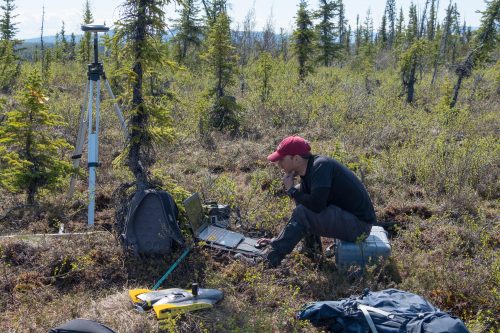
Kevin Turner working on field research in northern Canada. Image by Brent Thorne
This installment of our ongoing series on GIS and education in Canada features Associate Professor Kevin Turner from Brock University’s Department of Geography and Tourism Studies.
Jonathan Murphy: Hi Kevin, and thank you for taking the time to chat with us about your career and your program at Brock. How did your passion for geography start?
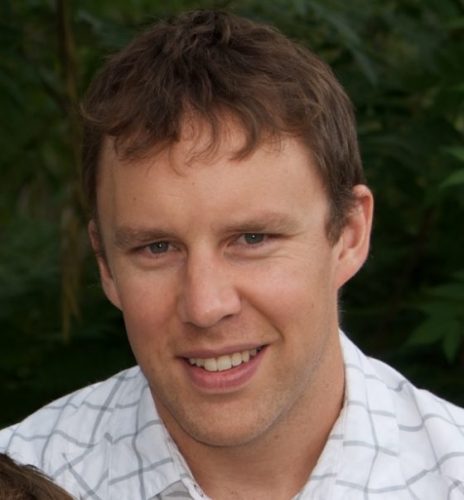
Kevin Turner: I was drawn to nature at an early age. I can trace my interests in geography and the natural sciences to various times starting in Grade 6 when Mr. Wayne Graham (Hamlet Public School, Stratford) put the class in contact with Daphne Sheldrick, the operator of an elephant orphanage in Kenya. While it may not have been geography-focused at the time, I became quite aware of the negative influence people can have on the world and the animals within it. My interest in Geography grew during my grade 11 geography class with Mr. Al Vredeveld at Stratford Central Secondary School. I also had the interests of a couple family members rub off on me. Add in a number of nature documentaries, family camping, a couple David Suzuki books, and some great advice from my high school academic advisor (Mrs. Heather Jesson), and soon I was off to Trent for my undergraduate joint major in physical geography and biology. I had some fantastic profs at Trent who continued to lure me into the natural sciences.
I was a tree planter during summers in northern Ontario, Alberta, and BC, which continued to build my appreciation for the outdoors. I knew that I wanted to study nature in some way and somehow set myself up to have a career that included working outside in a remote landscape. The motivation for this continued after graduation while hiking and mountaineering in Ecuador and Peru.
I decided that I wanted to learn more about landscape-scale systems and that building skills in digital mapping and spatial analysis was needed. I received a post-grad certificate in the GIS Applications Specialist program at Sir Sandford Fleming College and got my first ‘career’ job at a geophysical exploration firm out of Guelph, Ontario. I found myself designing projects and surveying in nice places around eastern Canada and the US. In addition to coordinating and conducting the field surveys, I wrote scripts in VBA to design the projects and quality check the data coming in, which I reported to clients.
I wanted more involvement on the research side of things, especially with water resources, and decided to begin graduate studies in 2007 at Wilfrid Laurier University. The timing was right considering that my new supervisor at the time (Dr. Brent Wolfe) and many other colleagues were beginning a multidisciplinary research program in Old Crow Flats, Yukon, supported by the Government of Canada International Polar Year. It was an incredible experience that presented many opportunities to travel to the north for fieldwork and interact with people of the Vuntut Gwitchin First Nation, who were the driving force of the program. Fast-forward 6.5 years and I’m beginning a position at Brock University where I secured external funding to build on my research in northern Yukon and also Northwest Territories.
Jonathan Murphy: You were recently promoted to associate professor at Brock–congratulations! What do you teach there and what is your research focus?
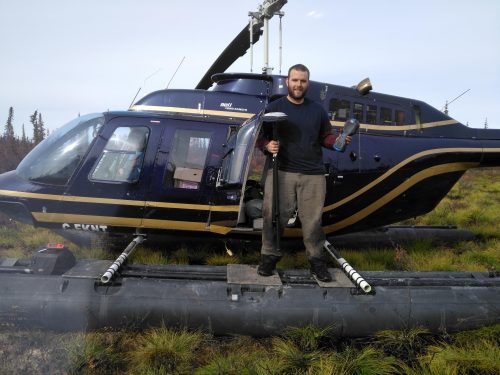
Graduate Research Assistant Brent Thorne, Image by Kevin Turner
Kevin Turner: My teaching focus in the Department of Geography and Tourism Studies at Brock is mostly geomatics. We offer a suite of geomatics courses spanning introduction and advanced remote sensing, GIS, cartography, and quantitative research design and methodology. Once students learn to grasp the various concepts, I encourage them to implement creative and critical analysis with datasets and topics that interest them most. I also strive to make them comfortable with using computer programming for automating tasks so they can accomplish more by generating useful customized tools of their interest. We’ve been lucky to have some very strong students come through our programs and it has been rewarding to see them enjoy and take a lot away from our programs.
Jonathan Murphy: What is the geography and tourism program like at Brock? What makes the program unique?
Kevin Turner: Within the Department of Geography and Tourism Studies, we have a diverse set of streams that students can pursue, which include the following:
- BA Geography (focus on human geography)
- BSc Geography (focus on physical geography)
- Concurrent BA or BSc (Honours) – Geography/ Education
- Combined Geography majors (e.g., Geography + Biology, Child and Youth Studies, Computer Science, Earth Sciences, Economics, History Labour Studies, and more)
We offer seven geomatics-focused courses as well as a fourth-year co-op course where students can gain additional hands-on experience in a position of their choosing. The wide-ranging options available provide students with the ability to shape their studies according to their interests. I take this approach with the four geomatics (i.e., mostly GIS and spatial analysis and statistics) courses that I teach. Students learn essential GIS/RS skills for evaluating spatial patterns throughout my courses and have opportunities to implement them within the context of their choice. The aim is to build their knowledge of geography and related fields through enhancing their analytical capabilities. We are lucky to work with the Brock University Map, GIS, and Data Library, which is conveniently located beside our department where students can have access to necessary resources for building their skills in geomatics. I pull a lot from my private sector and ongoing academic research experiences when updating and implementing my courses. I’m happy to report that following graduation, many students who have taken our courses have been quite successful at finding employment and/or additional research programs in their fields of interest.
Jonathan Murphy: What geomatics classes or skills are students acquiring by the time they graduate from Brock?
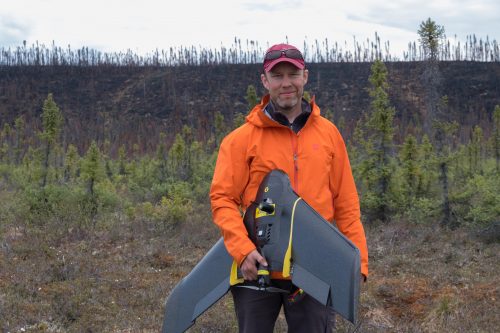
Kevin Turner. Image by Brent Thorne
Kevin Turner: Students learn to use many GIS/RS software for their analytical needs and interests. We have many computer labs throughout Brock University with site licenses for ESRI products including ArcMap and ArcGIS Pro as well as ENVI for remote sensing analyses. My courses also include a lot of content focused on open source solutions including R, QGIS, and various integrated development environments. In addition to utilizing databases for spatial analyses (3D, network, spatial statistical, etc.) and geoprocessing, my courses bring in application development so that they can learn to automate or customize their workflow in an effort to eliminate redundancies. This comes from using Python and R programming languages.
Jonathan Murphy: The program has some interesting aspects to it. Can you tell us a bit about the weeklong experiential learning exercise in central Ontario for the fourth year students?
Kevin Turner: We have several ‘experiential learning’ opportunities within our programs. It is geography after all and it is important to get students into the field to get hands-on experience. The Peterborough field course is the longest running one in the department where physical and human geography students get a chance to conduct their research of interest. We offer additional field courses for geography and tourism students to other national and international destinations that have included Croatia, Vancouver, and Chicago. London, England is on the list for next year. I take graduate and undergraduate students who are working on their theses for Geography and Tourism Studies or Earth Science with me to my northern study sites including Old Crow, Yukon, and Yellowknife, Northwest Territories.
Jonathan Murphy: I understand that 40% of your job is focused on research. Can you describe your research program and how you and the students working with you accomplish it?
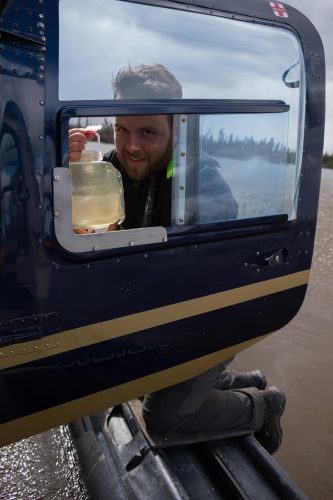
Research Assistant Brent Thorne. Image by Kevin Turner
Kevin Turner: My research program focuses on tracking climate-induced landscape changes and the associated responses of lakes and rivers in northern Canada. For example, the changes that myself and the people of Old Crow, Yukon have observed include an increased frequency of lake drainage, shoreline permafrost thaw slumping (i.e., landslides), shrub vegetation proliferation, and fire. Taking inventory of these phenomena requires the use of available remotely sensed data products and multispectral imagery we collect using unmanned aerial vehicles. Other datasets are coming from airborne campaigns of the NASA Arctic Boreal Vulnerability Experiment, which I am affiliated with. We also sample water and sediment from lakes and rivers, which undergoes a suite of water chemistry and isotope analysis. This information provides an indication of how the landscape changes have impacted water quality, hydrology and carbon export over multiple temporal scales.
Geomatics tools are essential at all stages of the research process including data acquisition, processing, analysis and integration of final catchment map layers (e.g., ground conditions, land cover type, ground temperatures, etc.). We also identify where lakes and rivers across the study sites are more vulnerable to being impacted by changing climate and landscape features. The overall aim is to provide key insight required for predicting how these places will respond to future change and how that will impact downstream environments.
Managing a northern research program in a southern Canada university can be a challenge. However, it is a chance of a lifetime for the students to venture out to important remote Canadian landscapes and work with stakeholders, including those who want to learn about the spatial patterns we see in their traditional territories.
Jonathan Murphy: Thanks for taking the time to talk to the GoGeomatics community. We hope to see you and your students at our monthly GoGeomatics socials in Niagara!
STORY REPOSTED FROM GOGEOMATICS
